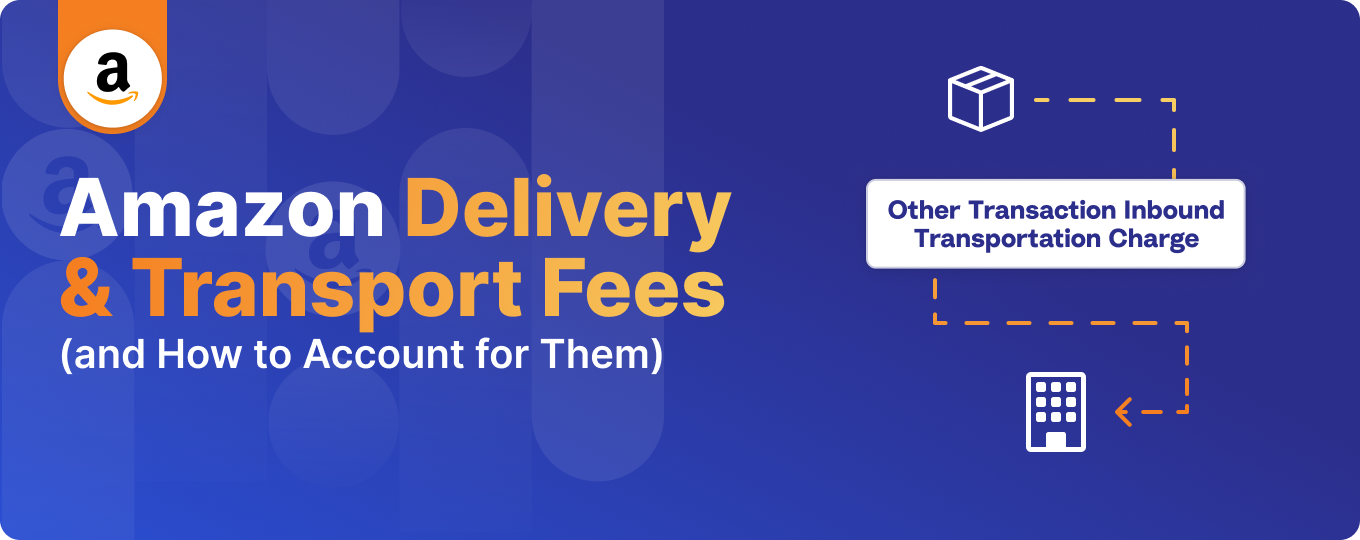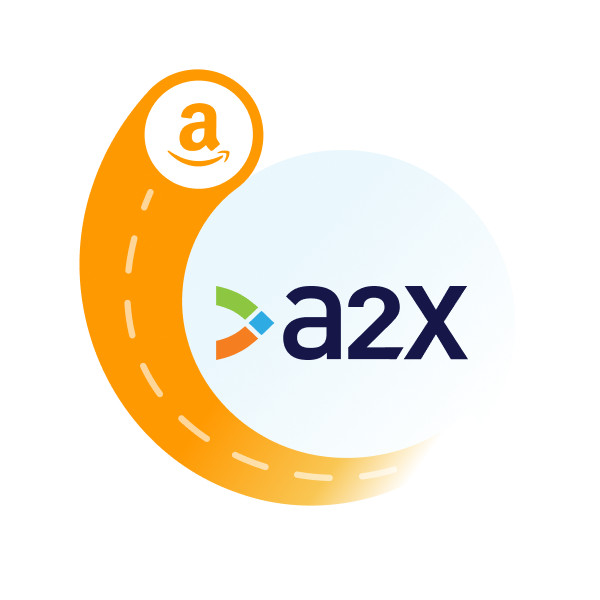Amazon Delivery and Transport Fees (and How to Account for Them)
Written by: Elspeth Cordray

Amazon presents a huge sales opportunity due to its vast audience of buyers. For sellers, this opportunity also comes with challenges – a big one being navigating the long list of fees and transactions associated with selling on Amazon.
One category of fees that can be difficult for sellers to grasp is “delivery and transport” fees.
In this guide, we’ll continue our series on how to account for different categories of Amazon transactions, and provide a deep dive into how to identify, record, and account for Amazon delivery and transport fees.
Key takeaways:
- What are Amazon delivery and transport fees? These fees primarily cover costs related to shipping inventory to Amazon’s fulfillment centers and integrating into Amazon’s network. They can also include charges for order fulfillment, packing, and customer deliveries.
- Examples of delivery and transport fees – Common fees include Non-Amazon Order Shipping Fees (for Multi-Channel Fulfillment orders), Inbound Transportation Charges (shipping inventory to Amazon), and FBA Inbound Transportation Program Fees (for discounted carrier services). Tracking these expenses helps sellers optimize costs.
- Accurate accounting for Amazon delivery and transport fees – Properly categorizing delivery and transport fees allows sellers to optimize profit margins, make informed inventory decisions, and evaluate fulfillment cost-effectiveness. Accurate bookkeeping also ensures financial reports are investor-ready and provides key insights for business growth.
What are Amazon delivery and transport fees?
Amazon delivery and transport fees primarily refer to fees that are related to shipping inventory inbound to Amazon’s fulfillment centers and integrating into Amazon’s network, but can also include charges that Amazon applies for storing, selecting, packing, and shipping products to customers.
Check out Amazon Fulfillment and Storage Fees (and How to Account for Them) for more information about fulfillment and storage fees. At a high-level, this broader category of fees can include:
- Fulfillment fees: For sellers using the Fulfillment by Amazon (FBA) program, Amazon charges fees for order fulfillment.
- Storage fees: Amazon charges for the space your inventory occupies in their fulfillment centers. These fees can fluctuate based on the season, with higher costs during peak times like the holiday season.
Examples of delivery and transport fees
As mentioned, delivery and transport fees can be closely related to fulfillment and storage fees, but usually refer to inbound transport costs. Some of the ways that delivery and transport fees will be listed on your Amazon seller statement include:
Non-Amazon Order Shipping Fees | Fees for using Amazon's Multi-Channel Fulfillment service to store and ship products for orders from non-Amazon channels. |
Other Transaction Inbound Transportation Charge | Costs for shipping items to Amazon's fulfillment centers, including broader expenses of integrating products into Amazon's network. |
Other Transaction Inbound Transportation Fee | Costs for sending inventory to Amazon's Fulfillment Centers using Amazon's partnered carriers, typically offering discounted rates. |
Other Transaction FBA Inbound Transportation Program Fee | Fees related to Amazon's FBA Inbound Transportation Program, covering discounted carrier costs and additional services. |
We recommend consulting Amazon Seller Central for more information about particular fees and transactions that might specifically relate to your store.
Why does accurate accounting for delivery and transport fees matter?
There are a number of reasons why Amazon sellers might not prioritize understanding their delivery and transport fees. Maybe you feel your volume of orders is too low, or perhaps you feel that your margins have enough buffer to absorb variable costs without needing to examine each one closely.
Or, maybe you’re overwhelmed by the complexity (you’re not alone in feeling this way!).
There are a number of benefits to accurately accounting for your Amazon delivery and transport fees, including:
- Optimizing your profit margins – Accurately tracking expenses like Non-Amazon Order Shipping Fees can help to pinpoint the exact cost of selling and delivering each item. This data can be used to set prices, determine which products are most profitable, and identify areas where costs can be trimmed.
- Making informed inventory decisions – Monitoring fees like the Other Transaction Inbound Transportation Fee can impact decisions about how much inventory to send to Amazon’s fulfillment centers, when to send it, and which products to prioritize.
- Evaluating cost effectiveness, especially between FBA and FBM – Keeping up-to-date with the fees associated with your choice fulfillment method can help you better understand if it’s the most profitable choice for your business.
- Getting external investment or loans – Potential investors are only interested in reviewing your business’s financial reports if they’re accurate down to the penny.
Accounting for Amazon delivery and transport fees using A2X
The only way to experience the benefits listed above is to keep your books and your finances accurate and up-to-date.
Accurate bookkeeping might sound daunting – but the good news is that A2X can help you account for all Amazon transactions, including delivery and transport fees, quickly and easily.
Watch this video for an overview of how A2X works.
Here’s how to get started with A2X.
1. Set up A2X
If you haven’t already, create an A2X account and integrate it with your accounting software (e.g., QuickBooks Online or Xero).
Then, connect A2X to your Amazon Seller Central account so A2X can send detailed summaries of your Amazon settlements to be matched to the bank feed.
2. Map your transactions to your accounts
In A2X, navigate to ‘Accounts and Taxes’. This is your “command center” where you can assign Amazon transaction types to corresponding accounts.
Use A2X’s Auto Setup feature to quickly and easily map your Amazon transactions to your Chart of Accounts. Answer the questionnaire, then choose the ‘Default’ setup to apply A2X’s default chart of accounts. (Note – You can update or change the account mappings later, if you need to.)
Here’s how A2X will typically map Amazon delivery and transport fees. Important: We recommend working with a specialized ecommerce accountant to make sure you have mapping set up correctly for your specific business needs.
Amazon Transaction | A2X Default Account | Account Type |
Non-Amazon Order Shipping Fees | Shipping Expense | Expense |
Other Transaction Inbound Transportation Charge | Amazon FBA Fees | Expense |
Other Transaction Inbound Transportation Fee | Amazon FBA Fees | Expense |
Other Transaction FBA Inbound Transportation Program Fee | Amazon FBA Fees | Expense |
If you’re selling on multiple marketplaces in different countries, you might also see a country or marketplace breakdown of your data.
3. Review and post
Go to the ‘Settlements’ tab in A2X. This is where you can see all of your Amazon settlements that have been fetched by A2X.
Click ‘Review’ on each settlement to review the transactions that make up the settlement, the amount, the account you’ve mapped it to, and the tax rate you’ve assigned (if any).
If all looks good, click ‘Send to [Your Accounting Software]’.
4. Reconcile
Open your accounting software. Locate the settlement that you just sent by A2X in your bank feed.
Review to make sure the amounts match, then reconcile.
5. Keep up with your bookkeeping
Repeat steps 3 and 4 on this list to make sure you’re keeping your books up-to-date! You can also set up A2X’s Auto-Posting feature to automate these steps.
Accounting and bookkeeping are most powerful when completed regularly because this will allow you to get accurate, up-to-date insights into your Amazon store’s financial health (and experience all of the benefits discussed earlier in this post).
How Amazon delivery and transport fees impact your P&L
When you map Amazon transactions in A2X and sync them with your accounting software, you’ll be able to see the implications they’ll have on your Profit & Loss (P&L), also known as your Income Statement.
Your P&L provides a summary of your revenue, costs, and expenses over a period. Given that most Amazon delivery and transport fees are costs, they will typically show up as expenses in your P&L under categories such as “Shipping Expense” or “Amazon FBA Fees”.
All these expenses reduce your overall profit. When you review your P&L, you’ll want to assess these fees to determine if they’re in line with your expectations and if any cost-saving measures can be applied.
If you’d like to get even more detail about how different Amazon transactions and fees are impacting your overall numbers, you can take it a step further and create additional accounts and then use A2X to map specific transactions to these accounts. They will then appear as separate line items in your P&L.
Regularly reviewing your P&L often answers the “why” of keeping up with regular bookkeeping for your Amazon store. Understanding how transactions such as delivery and transport fees affect your financial statements is crucial for assessing the health of your business and for making informed financial decisions. You’ll get better insights into your expenses, how much you owe, and the overall profitability of your Amazon operations – and that’s what leads to business success.
Amazon accounting and bookkeeping is easy with A2X
Ready to make sense of your Amazon transactions and get your books in order? Sign up for a free trial of A2X for QuickBooks Online or A2X for Xero today!
Learn more about Amazon seller fees and transactions and how to account for them:
- Amazon Order Revenue Transactions (and How to Account for Them)
- Amazon Commission and Selling Fees (and How to Account for Them)
- Amazon Fulfillment and Storage Fees (and How to Account for Them)
- Amazon Subscription Fees (and How to Account for Them)
- Amazon Reserve Balances (and How to Account for Them)
- Amazon Reimbursements (and How to Account for Them)

Integrate Amazon and your accounting software for accurate accounting
A2X auto-categorizes your Amazon sales, fees, taxes, and more into accurate summaries that make reconciliation in your general ledger a breeze.
Try A2X today
